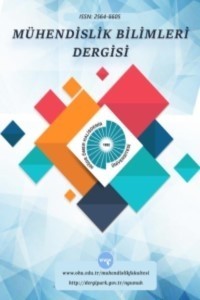Öz
Evrimsel Yapı Optimizasyonu (ESO) yönteminde amaç; yapı içerisinde
gerilmelerin düzgün dağılım sağlamasıyla ağırlık ve rijitlik bakımından en
ideal yapıya ulaşmaktır. Yapı tasarımı için yeni olan ESO yönteminde, başlangıç
tasarım alanındaki elemanlar bir döngü içerisinde belirli kıstaslar dahilinde
çıkarılma işlemiyle gerçekleşmektedir. Bu döngü, ideal tasarım elde edilene
kadar tekrarlanmaktadır. Elde edilen ideal model, Çubuk Benzeşim Metodunun
(STM) başlangıcı için optimum model olarak kabul edilebilmektedir. Çubuk
Benzeşim Metodu, kirişleri çubuk sistemine çevirerek elemanların paralel-yatay
çubuk gibi davrandığı kabul eden yöntemdir. Bu çalışmada, farklı yüklemelere
maruz köprü kirişinde, ESO yönteminde elde edilen optimum tasarımın STM modeli
için uygunluğu incelenmiştir. Ayrıca farklı yüklemeler için optimum tasarım
örneklemeleri sunulmuştur. ESO yönteminde eleman çıkartılma döngüsü ANSYS sonlu
elemanlar programı yardımıyla gerçekleştirilmiştir.
Anahtar Kelimeler
Evrimsel yapı optimizasyonu çubuk benzeşim metodu yapı dizayn ANSYS
Kaynakça
- [1] TANSKANEN P., “The Evolutionary Structural Optimization method: Theoretical Aspect”, Computer methods in Applied Mechanics an Engineering, vol.20, pp. 500-515, 2002.
- [2] UYSAL H., Duyarlılık Analizi Kullanılarak Kabuk Yapıların Şekil Optimizasyonu, Yüksek Lisans Tezi, Atatürk Üniversitesi Fen Bilimleri Enstitüsü, Erzurum, Türkiye, 2002.
- [3] STEVEN G.P., XIE Y.M., “Evolutionary Structural Optimization”,Springer, 1997.
- [4] HINTON E., SIENZ J., “Fully and Stressed Topological Design of Structures Using an Evolutionary Procedure”, Engineering Computations, 1995.
- [5] TJHIN R.N., KUCHMA D.A., “Integrated analysis and design tool for the strut and tie method”, Engineering Structures, vol. 29, pp. 3042-3052, 2007.
- [6] ÖZKAL F., Üç Boyutlu Konsol Kirişlerde Topoloji Optimizasyonu Uygulamaları, International Journal of Engineering Research and Development, 2010.
- [7] ALMEIDA V.S., SIMONETTI H.L., NETO L.O., “Comparative analysis of strut-and-tie models using Smooth Evolutionary Structural Optimization” Engineering Structures, vol. 56, pp. 1665-1675, 2013.
- [8] MORADI M., ESFAHANI M.R., “Application of the strut-and-tie method for steel fiber reinforced concrete deep beams”, Construction and Building Materials, vol. 131, pp.423-437, 2016.
- [9] OKAHASKI Y., PANTELIDES C.P., “Strut-and-tie model for interior RC beam-column joints with substandard details retrofitted with CFRP jacket” Composite Structures, vol. 165, pp. 1-8, 2017.
- [10] ZHONG J.T., WANG L., DENG P., ZHOU M., “A new evaluation procedure for strut-and-tie model disturbed regions of reinforced concrete structures” Engineering Structures, vol.148, pp.660-672, 2017.
- [11] HANOON A.N., JAAFAR M.S., ZAIDEE S.R., HEJAZI F., AZIZ F.N.A., “Effectiveness factor of the strut-and-tie model for reinforced concrete deep beams strengthened with CFRP sheet” Journal of Building Engineering, vol.12, pp.8-16, 2017.
- [12] YAVUZ G., Betonarme Kısa Konsolların Davranışlarının Deneysel Olarak ve Kafes Sistem- Strut and Tie Modellemesiyle İncelenmesi, Yüksek Lisans Tezi, Selçuk Üniversitesi Fen Bilimleri Enstitüsü, Konya, Türkiye, 1999.
- [13] ACI 318, Building code requirements for reinforced concrete, American Concrete Institute, Detroit, USA, 2008.
DESIGN EVOLUTIONARY STRUCTURAL OPTIMIZATION AND STRUT-and-TIE METHOD IN DIFFERENT LOADING EXPOSED TO BEAM
Öz
The purpose of the Evolutionary Structure Optimization (ESO) method is
to achieve the optimum structure in terms of weight and stiffness with uniform
distribution of stresses in the structure. ESO methods for building design, the
elements in the initial design field are generated by subtraction within
certain criteria in a loop. This loop is repeated until the ideal design is
obtained. The obtained ideal model can be acceptedas the optimum model for the
Strut-and-Tie Method (STM). STM is a method that turns the beams into a rod
system and assumes that the elements behave like a parallel-horizontal rod. In
this study, optimum design samples with obtained by Evolutionary Structure
Optimization method was investigated for suitability of Strut-and-Tie Method on
bridge beam subjected to different loads. In addition, optimum design samples
are presented for different loads. In the ESO method, the element removal loop
is carried out by using ANSYS finite element software.
Anahtar Kelimeler
Evolutionary structural optimization strut-and-tie method structure design ANSYS
Kaynakça
- [1] TANSKANEN P., “The Evolutionary Structural Optimization method: Theoretical Aspect”, Computer methods in Applied Mechanics an Engineering, vol.20, pp. 500-515, 2002.
- [2] UYSAL H., Duyarlılık Analizi Kullanılarak Kabuk Yapıların Şekil Optimizasyonu, Yüksek Lisans Tezi, Atatürk Üniversitesi Fen Bilimleri Enstitüsü, Erzurum, Türkiye, 2002.
- [3] STEVEN G.P., XIE Y.M., “Evolutionary Structural Optimization”,Springer, 1997.
- [4] HINTON E., SIENZ J., “Fully and Stressed Topological Design of Structures Using an Evolutionary Procedure”, Engineering Computations, 1995.
- [5] TJHIN R.N., KUCHMA D.A., “Integrated analysis and design tool for the strut and tie method”, Engineering Structures, vol. 29, pp. 3042-3052, 2007.
- [6] ÖZKAL F., Üç Boyutlu Konsol Kirişlerde Topoloji Optimizasyonu Uygulamaları, International Journal of Engineering Research and Development, 2010.
- [7] ALMEIDA V.S., SIMONETTI H.L., NETO L.O., “Comparative analysis of strut-and-tie models using Smooth Evolutionary Structural Optimization” Engineering Structures, vol. 56, pp. 1665-1675, 2013.
- [8] MORADI M., ESFAHANI M.R., “Application of the strut-and-tie method for steel fiber reinforced concrete deep beams”, Construction and Building Materials, vol. 131, pp.423-437, 2016.
- [9] OKAHASKI Y., PANTELIDES C.P., “Strut-and-tie model for interior RC beam-column joints with substandard details retrofitted with CFRP jacket” Composite Structures, vol. 165, pp. 1-8, 2017.
- [10] ZHONG J.T., WANG L., DENG P., ZHOU M., “A new evaluation procedure for strut-and-tie model disturbed regions of reinforced concrete structures” Engineering Structures, vol.148, pp.660-672, 2017.
- [11] HANOON A.N., JAAFAR M.S., ZAIDEE S.R., HEJAZI F., AZIZ F.N.A., “Effectiveness factor of the strut-and-tie model for reinforced concrete deep beams strengthened with CFRP sheet” Journal of Building Engineering, vol.12, pp.8-16, 2017.
- [12] YAVUZ G., Betonarme Kısa Konsolların Davranışlarının Deneysel Olarak ve Kafes Sistem- Strut and Tie Modellemesiyle İncelenmesi, Yüksek Lisans Tezi, Selçuk Üniversitesi Fen Bilimleri Enstitüsü, Konya, Türkiye, 1999.
- [13] ACI 318, Building code requirements for reinforced concrete, American Concrete Institute, Detroit, USA, 2008.
Ayrıntılar
| Birincil Dil | Türkçe |
|---|---|
| Konular | İnşaat Mühendisliği |
| Bölüm | İnşaat Mühendisliği |
| Yazarlar | |
| Yayımlanma Tarihi | 20 Temmuz 2018 |
| Gönderilme Tarihi | 13 Eylül 2017 |
| Kabul Tarihi | 21 Şubat 2018 |
| Yayımlandığı Sayı | Yıl 2018 Cilt: 7 Sayı: 2 |
Kaynak Göster


